
20 minute read
Maserati Granturismo S
In normalconditionsthe valvesare closed, forcing the exhaustgasesalonga long and tortuousrouteso thattheylosetheirenergy and are emittedoutwardswithverylittle noise. Thisallchangeswhenthe "Sport" buttonispressed: the valveswhichwere initiallyclosed, open up througha pneumaticcontroland the flow ofexhaustgasesis channelleddown a routethatleadsdirectly tothe outside. Thisprovidesenthusiasts witha distinctiveresonance. IfnotactivatedusingSport mode, the pneumaticvalves open up above3000rpm.
Transmission
Transaxlelayout withthe longitudinalenginefront-mountedbehindthe frontaxle, rigidlyconnectedbymeansofa steel tube tothe longitudinalgearbox, whichisrearmountedin unitwiththe differential.
Robotizedgearboxelectro-actuated6-speed transmission, withhydraulicmanagement operatedelectronicallyusingthe paddlesmountedbehindthe steeringwheel, integral withthe steeringcolumn. Triple-conesynchroniserson 1st and 2nd, and doublecone on 3rd, 4th, 5th and 6th.
Dry twin-plateclutchofdiameter215 mm withtorsionalflexiblecouplingsand hydraulic control.
Steel 20 mm propshaftflexiblysupportedon fourbearingsinside anengine-gearbox connection pipe.
Segmentedlimited-slipdifferentialwithasymmetricallockfactor(25% in traction, 45% in release).
Maserati StabilityProgram(MSP), integratingtractioncontrol(ASR), releasetorque regulation(MSR), anti-lockbraking(ABS) and electronic brakeforcedistribution(EBD).
Transmissiongearratios
Rearaxleratio
Tofullyharnessthe operatingrangeof itsnew440 HP V8 4.7 engine, the GranTurismoS isequippedwithRobotizedgearboxtransmission, in keepingwiththe recenttraditionofMaserati's more sportymodels. Thistechnologyispart ofMaserati's DNA and derivesfromthe Trident's closelink withthe world ofracing. In contrastto previousversions, the system alsoincorporatesthe MC-SuperFastshiftfunction, which furtherreducesgearshifttimesduringsportsdriving.
In technicalterms, Robotizedgearboxisan electro-actuatedmechanicaltransmission withdry twin-plateclutch, sixspeeds(plus reverse) and triple-conesynchroniserson 1st and 2nd, and dualconeon the othergears. The hydrauliccontrolismanagedby the controlunitthroughthe paddlesintegral withthe steeringcolumn, the layout of whichishighlyergonomicand effectivein extremedrivingconditions, asamply demonstrated.
The six-speedgearboxincorporatesa dual-plateclutch, a solutionderivedfromthe world ofcompetitive racing whichisparticularlyrecommendedforthe mostsportycars. The reduceddimensionsofthe clutchunit(Ø 215 mm), and the small-diameter flywheel(Ø 240 mm), keepthe weightofthe unitdown significantly, and clearly reducesthe powerunit's total inertiacomparedtoa single-platesystem. Thistypeof arrangementallowsthe top enginespeedtobe reachedmore easily, and resultsin a more immediate gearboxresponse, quickergearchangesand, finally, improveddriving dynamics.

Gearbox
Robotizedgearboxhastwomainoperatingmodes, MANUAL and AUTO.
Bothmodescan beoverlappedwiththe SPORT function, whichmakesgearchanges quicker. In particular, in MANUAL+SPORT mode the Maserati GranTurismoS activatesthe innovative MC-SuperFast gearshiftfunction.
The Maserati GranTurismoS Robotizedgearboxsystem hasa total ofsixoperating modes:
• ManualNormal
• ManualSport
• ManualSport withMC-SuperFastshift
• Auto Normal
• Auto Sport
• Ice
MC_S Superprestazionale
SPORT Prestazionale
NORMAL Comfort
Manual Normal
Pedale acceleratore
In MANUAL NORMAL mode the valvesare closedand the choiceofgearliessolely withthe driver. Toensuregreaterdrivingenjoymentthe system holdsthe gearwhen the limiterisreached; the controlunitmerelychecksthatthe gearrequestedmatches enginespeed, so astoavoidtakingitbeyondthe limiterwhenshiftingdown (AUTOUP) or belowthe minimum speedwhenshiftingup (AUTO-DOWN).
Withenginespeedabove4,000 rpmand the acceleratordepressedthroughmore than 80% ofitstravel, the fuelcut-off strategyisactivatedon eachgearchange: duringthe gearshiftthisfunctionshortensthe time takentodischargetorqueand limitsengine speedreduction, enablingquickergearshifts.
Manual Sport
In MANUAL mode, pressing the SPORT buttoncausesthe transmissioncontrol system toadopta more performance-orientedgearshiftstrategy, withmuchshorter timestochangebetweenoneratioand another.
In MANUAL SPORT mode the pneumaticexhaustvalvesopen: besidescontributingto a fullerand deeperenginesound, the reducedbackpressuregeneratedallowsthe enginespeedtoincreasemore quicklyand achievea highermaximumpower.
Whenmovingdown tolowergears, eachshiftisaccompaniedbya more pronounced heel-and-toeeffect.
MC-SuperFastShift
The MC-SuperFastgearshiftfunctionisthe mostrecentinnovationofthe electroactuatedRobotizedgearboxsystem: thismode exploitsthe elasticenergyofthe transmissionpartsand deliverstop performance in termsofgearshifttimes. This meansthatthe shifttime(calculatedasthe break in acceleration) dropsto100 ms, ensuringmaximumsports characteristicsand exhilaratingdriving.
Gearshift time
MC-SuperFAST
Break in acceleration drops to 100ms t1t2t3 time
Gear engagement time: 40ms
– Clutch open / engine torque reduced t1
– Clutch closed / engine torque restored t3 t2
– Gear disengagement/selection/engagement
The Robotizedgearboxmanagement software enablesgearengagement/ disengagementtotake placein parallelwiththe opening/closingofthe clutch. In this way the gearshifttime, whichiscalculatedaccordingtothe accelerationgap (and not just the timeittakestoengagethe gear) isreducedbyactivatingthe various operationsat overlappingtimes:
1.Torqueinterruptionand clutchdisengagement
2.Geardisengagement, selectionand engagement
3.Clutchengagement and torquerecovery
Cambiata Sport
Cambiata MC-SuperFast
The variousshiftphases(torqueinterruptionand clutchopening; geardisengagement, selectionand engagement; torquerecovery and clutchclosing) are carriedout nonsequentially.
The MC-SuperFastshiftisavailableonlyin MANUAL SPORT mode, providedthatthe transmissioncontrolunitrecogniseswhengivenparametersrelatingtoengineand transmissiontemperature are achieved.
Once theseparametershavebeenachieved, the system enablesSuperFastshift, and warnsthe driver throughthe MC-S indicatoron the dashboarddisplay, whichlightsup. SuperFastshiftispossibleabove5500 rpmand withthe throttleat 80%.
SuperFastshiftisavailableonlywhenshiftingup and in Sport mode. Withregardto gearboxhardware, in ordertosupportSuperFastshiftthe hydraulicpumphasbeen oversizedtoaccommodatethe increasedpressureofthe system, whichunder extreme conditionsistwiceashigh comparedtoconventionaluse. A directwireconnection has beeninstalledbetweenthe transmissioncontrolunitand the enginecontrolunit, to increasethe communicationspeedwithrespecttothe conventionalCAN communicationline.
Whenis MC-SuperFast SPORT shiftavailable?
SuperFastshiftisonlyavailablein MANUAL SPORT mode.
Withthe vehiclein a steady state withF1 Kit oil and enginecoolant, in ManualSport mode the letters MC-S light up on the dashboarddisplay.
Specifically, thismeanswhenthe followingconditionsare present:
•Enginespeed> 5500 rpm
•Acceleratorpedalfullydepressed(>80%)
•Lateralacceleration<0.9g
•ASR inactive
•No wheelslip
Note: WithMC-S Sport at anenginespeedof>5500 rpmand the acceleratorfully depressed, ifforexampleASR isactivatedthena standard shiftoccursand SuperFast shiftisDISABLED.
Hardware modificationsmadewithrespecttopreviousMaserati Robotized gearbox version(M139 SofastIII)
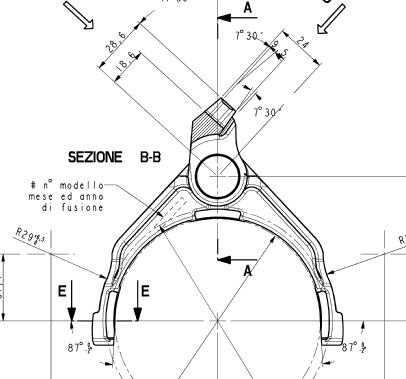
•Mechanicalgearbox: reinforcedcontrolleversand three-padshiftforks. Introductionofthirdpad, taperaddedtoshiftfork, molybdenumsurfacetreatment ofincreaseddepth. Material 40CD4.
•Reinforcedgearbox.
•Ribbedfinger clutch(Note: kisspointstillat 4.2mm = 327 bit)
•Oversizedpump+ pumpair conveyor
•Eliminationofthrottles
•Reverse lightsoperatedvia CAN
•New F1 Kit oil SHELL DONAX TX ~0.5 litres
•DirectTCU –ECU connection forenginefuelcutoff requestin SuperFastshiftmode.
•New pushbuttonpanelwithdouble-switch pushbuttons.
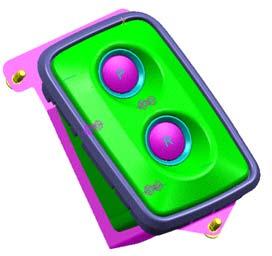
Hardware modificationsmadewithrespecttopreviousMaserati Robotized gearboxversion(M139 SofastIII):
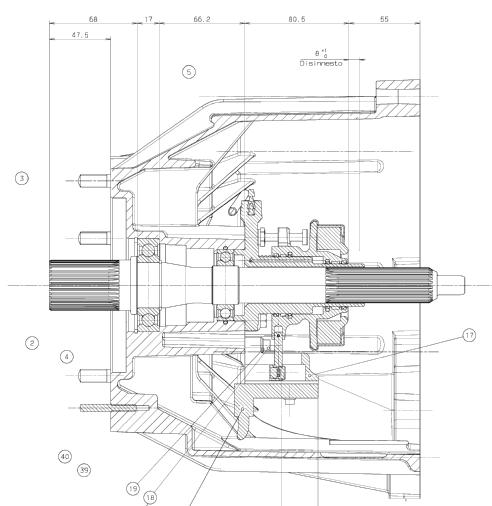
•Double-supportclutchhousing
Software modificationsmadewithrespect tolast Maserati Robotizedgearbox version(M139 SofastIII):
•Automaticwitheasy-exit
•Robotizedgearboxvs EPB (Pre-Releaseand Sprint performance)
•Reverse buzzerafter4 sec
•Automaticgeardisplay
•SuperFastShift
•Gearheldwhenlimiterreachedin MANUAL NORMAL and MANUAL SPORT
AUTO NORMAL Mode
In Auto mode the gear change is managed completely automaticallyby the transmission electronic control system. The control unit determines engine speed and moment of the shift as well as its speed, based on parameters such as vehicle speed, engine speed and the driver's request for torque and power. In AUTO mode a gear can also be requested manually through the paddles behind the steering wheel (gear suggestion).
The system recognises the type of driver by means of functions that assess the driver's style of driving through lateral and longitudinal acceleration and accelerator pedal movement. If a sportier driving style is recognised, the "UP" shifts are moved to a higher number of engine revs. The control system also recognisesthe type of road, adapting gear changes when the road climbs or falls, on a bend, in town and on motorways.
AUTO NORMAL mode is the mode most designed for comfort: changingto a higher gear is required as soon as possible in order to obtain the lowest level of vibrations and acoustic return from the engine. Shifting is managed in such a way as to ensure that gear changes are ultra-smooth. This mode also ensures lower fuel consumption when combined with a normal and non-aggressive driving style. In AUTO NORMAL mode the sporty exhaust by-pass valves stay closed, which results in greater acoustic comfort whilst driving.
This does not mean, however, having to give up on the car's sporty nature: during sports driving, with frequent opening of the throttle, gearshiftspeeds approach those of the AUTO SPORT mode.
AUTO SPORT Mode
AUTO SPORT mode isactivatedwiththe transmissionin auto mode and bypressing the SPORT buttonlocatedon the centredashboard: gearchangingisstillmanaged automaticallybythe transmissioncontrolunit, butbyvaryingthe speedofthe operationstoopen up and reduce torque, disengage, selectand engagegear, close the clutchand restoreenginetorque. The resultisa fastergearchangeand a more sportydrivingfeel.
ComparedtoAUTO NORMAL mode, shifting up takesplaceat higherenginespeeds, whereasmovingdown a gearisaccompaniedbya more pronouncedheel-and-toe effect.
In AUTO mode aswell, withthe SPORT buttonon, the pneumaticexhaustvalvesopen so thatthe enginecan achievetop performance: besidescontributingtoa fullerand deeperenginesound, the reducedbackpressuregeneratedallowsthe enginespeedto increasemore quicklyand achievea highermaximumpower.
ICE Mode
Thismode can beusedon particularlyslipperyroad surfaces(snow, ice), or more generallyin low-gripconditions. Itisactivatedthroughthe ICE buttonlocatedon the centretunnel. Whenswitchedon, the system avoidshavingtorunthe engineat more than3,000 rpm.
ICE mode takespriorityoverSPORT and MSP OFF modes: thismeansthatwhenthe driver requeststhe ICE mode, Sport mode isdeactivatedautomatically(ifitwason) and the stabilitycontrol(MSP) restored(ifpreviouslydeactivated).
Whenthe carisstarted, the Robotizedgearboxconfigurationisthe sameaswhenthe enginewasswitchedoff. Onlyifthe enginewasswitchedoff in MANUAL mode does the transmissionpresentitselfin easy-exitAUTO mode. In thisconfigurationthe gear changelogicisautomatic, butwhena gear isrequestedwiththe carmoving(gear suggestion) the system changestoMANUAL mode. Ifthe enginewasswitchedoff in NORMAL/SPORT mode, Robotizedgearbox alsopresentsthe sameconfiguration whenthe carisrestarted.
Self-learning
Allthe self-learningproceduresofthe M139 Robotizedgearboxstillapply, in addition toa newself-learningprocedure knownasSuperFastShift. Thisprocedure is performedafterthe gearself-learning procedure and the key-OFF key-ON
Thisprocedure isusedtoself-learnthe solenoidvalve disengagementtimes. Itmustbeexecutedeachtimethatself-learningmustbeexecutedon the gearchange grids(Grid Self-Learning1)
It must be executed after Grid Self-Learning 1 and after having removed the key.
Proceed to SD3 with key ON in the same way as for the execution of Grid SelfLearning1.
Once startedyouwillhear13 clicks(selection) and thiswillbefollowedby3 gear changesin orderfrom1st, 2nd, 3rd, 4th and 5th. NOT 6th or REV
SuperFastShiftWarning
WithSuperFastshiftactive, the pumpworksharderand the system pressurerises from40-52 bar to 52-70 bar. Consequentlyanoversizedpumpand a coolingconveyor havebeenintroduced. In addition, 3 differentrecoveriesare enactedbythe system software
Greater stress isexertedon the controlleversand mechanicalgearboxshiftfork. Thesecomponentshavethereforebeenreinforced.
RECOVERY LEVEL 1:
A -Reduction of pump switch-off pressure threshold
B -Reduction in dither amplitude of proportional solenoid valves

C -Clutch autocalibration disabled
D -Reduction in time taken to engage neutral and close clutch due to absence of commands pending breakaway acceleration (calibrated out-of-range)
RECOVERY LEVEL 2:
-recovery of level 1
E -gear shift limitations: in manual mode the overspeed and underspeed thresholds are modified to reduce the number of shifts.
In automatic mode, dedicated gearchange maps are used to reduce the number of shifts
F -Elimination of SuperFast Shift
RECOVERY LEVEL 3:
G -recovery of level 1 and level 2
H -Pump switched off so that its temperature returns to within normal operating limits.
A, B, C, D, E, F, G, H: still in calibration phase
Servicing Operations For Cars Equipped With Sofast 4 Gearbox Management System
MASERATI M145 Allmarkets
HW CFC 301(hardware identicaltoSOFAST III)
Clutchreplacement
Clutchbleedingprocedure
CalibrationofDEIS parameters
Kisspoint(includesresettingthe clutch degradationindexand configuringthe clutch)
Self-learning
Gearboxreplacement
Hydraulicactuatorreplacement
ReplacementofsolenoidvalvesEV12-3-4-5
SuperFastShift
Hydraulicactuatorbleeding
Self-learning
SuperFastShift
Gearboxactuatorbleeding
Self-learning
SuperFastShift
Clutchactuatorbleeding
Replacementofclutchsolenoidvalve EVF
Pumpreplacement
CalibrationofDEIS parameters
KissPoint (includesresettingthe clutch degradationindexand configuringthe clutch)
Hydraulicactuatorbleeding
Remote loadingofsoftware
CalibrationofDEIS parameters
Self-learning
SuperFastShift
NCR replacement
Readingofclosedclutchvaluefromnewon the replacedNCR and settingofthisvalue on the newNCR
Autocalibrationofaccelerationsensoroffset Kisspoint
Accelerationsensorreplacement or ABS unitreplacement
Autocalibrationofaccelerationsensoroffset
Note: In anyevent, itisadvisabletore-executethe self-learningprocedures (DEIS; Self-Learning, SuperFastShift, Accelerometer) duringeachservicing operation
Single-ratingsportssuspensiontoenhancethe sportydrivingfeel
The Maserati GranTurismoS offersthe samesuspensionlayout asthe 4.2 L engine version. However, italsofeaturesa specialdevelopmentdesignedtoreallyexploit the greaterpoweroutput ofthe 4.7 V8 and harnessthe capabilitiesofferedbythe Transaxlesystem.
The Maserati GranTurismoS isfittedasstandard withfixed-ratingsteel dampers modifiedwiththe introductionofnewspringsand dampers, whichoffer10% more dampingforceand are repositionedin termsofcompression/extensionratioso asto match the car's differentspecification. The diameterof the reartorsionbar hasalso beenincreasedtomakeitmore rigid. Thesemodificationshaveresultedin a 10% reductionin body rollwhich, combined withthe excellentweightdistribution, makesthe Maserati GranTurismoS particularly agile and responsivetodriver instructions: in a successionofbendsitappearsquick and intuitive whenenteringand findingthe centreof the bendand speedywhen negotiatingthe bend. Furthermore, the driver can accelerate earlierwhencomingout ofthe benddue tothe reducedloadtransfers.
As analternative tothe standard fixed-ratingsuspension, the Maserati GranTurismoS maybeprovided, uponrequest, withSkyhookelectronic controlsuspensionsfeaturing aluminiumbody damperswithcontinuousdampingvariation; in thiscase the hardware modificationsare accompaniedbyspecialmanagement software.
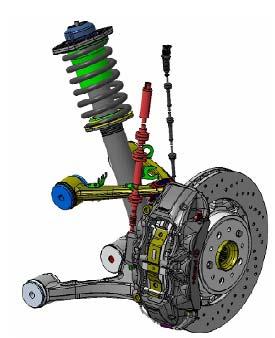
The Skyhook electronic suspension management system is able to continuously monitor the suspension damping: the system acts through acceleration sensors which record the movements of each wheel and thus ensure that any surface unevenness is absorbed and the highest level of comfort guaranteed. A further advantage of the Skyhook electronic suspension controlsystem is that the driver can choose from two different settings: Normal, which allows travel with the highest level of driving comfort, and Sport, which gives a harder ride setting with more reduced roll angles and load transfers, thereby enhancing the agility and stability of the car body. In the Sport configuration the handling of the Maserati GranTurismo S is comparable with that guaranteed by fixed-rating dampers. The choice of suspension is very much dependent on driver preference: single-rating dampers make the driver feel more "at one" with car, which will convey the slightest change in road condition, without being filtered by the electronics. Thanks to the operation of the electronic control, the Skyhook suspensions ensure the best compromise between comfort and handling in all driving conditions.
Vehicle alignment
angleInt. 34.15°/ext.40.2°
Static load configuration: full fluid levels (including fuel) plus 75+75 kg on the front seats.
Brakingsystem -dual-casttechnology
The Maserati GranTurismoS isfittedwitha high-performancebrakesystem, which usesdual-casttechnologyforthe frontbrakediscs, developedin collaborationwith Brembo and usedforthe first timein the automotivefieldon the Maserati Quattroporte Sport GT S.
In contrasttoconventionalcast-irondiscs, the dual-castdisc consistsofa cast-iron brakingring and analuminiumhub, makingitpossibletocombine the advantages offeredbycast iron's performance at temperature withthe aluminium's light weight.
1) Cast ironfrictionring
2) Aluminiumcentralpart
At the front, the dual-castdiscsare combinedwithsix-pistonaluminiummonobloc brakecalipersofdifferentiateddiameter(30/34/36 mm), withFerodo HP1000 pads. The monobloccalipersare more resistanttodeformationthancalipersmadeoftwo parts; thismeansthatlightermaterials, in thiscase aluminium, can beusedand componentweightminimisedevenfurther. The caliperisalsomore efficientat any operatingpressureand thistranslatesintolighteruseofthe pedalusewhenbraking.
At the rear, 330 x 28 mm discsare fittedwith4-piston calipersofdifferentiated diameter(32/36 mm), and Jurid673 GG pads.
The brakecalipersfittedasstandard on the Maserati GranTurismoS are red. The customermaypersonalisethe colourofthe calipersbyselectingfromoneofa further 5 alternative shades: Titaniumand Yellow fora more sportylook, Silver and Bluefora more elegantconfiguration, or the classicBlack.
The brakingsystem in the Maserati GranTurismoS alsofeaturesABS, whichprevents the wheelsfromlockingup whenbraking, and EBD forbetterdistributionofbraking forcebetweenthe frontand rearwheels, bothintegratedwithMSP Bosch version8.0.
Hill Holder and Electric Parking Brake (EPB)
The Maserati GranTurismo S is equipped with the "Hill Holder" function, which aids the driver during hill starting. The device holds the car braked fora few seconds (the time varies depending on road incline), so that the driver has time to move his foot from the brake pedal to the accelerator pedal without the car moving. Similarly to the model with automatic transmission, the MaseratiGranTurismo S is equipped with an Electric Parking Brake (EPB). This system, in addition to making handbrake actuation easier, means that the driver can forget all about activating/deactivating the park brake, since it engages automatically when there is no engine power and deactivates whenthe accelerator pedal is pressed.
In place of the traditional mechanical lever, the electric park brake can be switched on simply by activating an electric control located on the centre tunnel. Whenever the car has to be moved with the engine off, the automated switch may be disabled using the "Park off" button in the central portion of the dashboard.
Parking Sensors
Withthe ignitionkey in the ON position, the frontand rearparking sensorsare activatedautomaticallywhenreverse gearisengaged.
Ifthe carisequippedwithfrontsensors, thesesensorscan beactivatedbypressing button A; whenthe frontsensorsare active, the buttonisbacklitwithanamberlight. Toswitchoff the frontsensors, press A once again. Allthe sensorsremainactivewhen reverse gearisdisengaged. The rearsensorsremainactivefor 60 secondsuntilthe vehiclespeedreachesaround18 km/h. The frontsensorsremainactiveuntilthe vehiclespeedreachesaround18 km/h (11 mph). On activationofthe frontor rear sensors, a beeper warnsthe driver thatthe system isactive. Whenthe sensorsare on, the system beginsemittingbeepsassoonasanobstacleisdetected. The beep frequencyincreasesasthe vehicleapproachesthe obstacle. The beepsare emitted fromtwobeepers, onelocatedunder the dashboard(ifthe vehicleisequippedwith frontsensors) and oneneartothe luggagespace(ifthe vehicleisequippedwithrear sensors). Whenthe obstacleislessthan35 cm fromthe bumper, a continuousbeepis emitted. The beepstopsimmediatelyif the distancefromthe obstacleincreases. The tone cyclesremainconstantifthe distancemeasuredbythe centralsensors remainsunchanged. Howeverifthe samesituation occurswiththe side sensors, the beepisinterruptedafter7 seconds, toavoidcontinuousbeepingwhenmanoeuvring alonga wall, forexample.
The distancefromthe obstaclescan alsobeviewedon the instrumentpanelbymeans ofa graphicdisplay, whichshowsthe vehiclesurroundedbysymbolsindicatingthe detectedobstacle's distance(maximum, medium and minimum distance) and position (front/rear, central/side). The colourrepresentsthe distance, the fieldrepresentsthe position. The maximumdetecteddistanceisdisplayedin green, the medium in yellow and the minimum in red. Ifthe vehicleisonlyequippedwithrearsensors, the front sensorsare omittedfromthe graphicdisplay. Ifthe vehicleisequippedwithfrontand rearsensorsand onlythe front sensorsare active, the rearsensorsare omittedfrom the graphicdisplay.
Stop &Gofunction
The carisequippedwitha Stop &Gofunction, whichcan beactivatedbymeansofthe Multimedia System. The Stop &Gofunction can beenabled/disabledfromthe “Setup” menu, byselectingthe option“Definevehicleparameters”, selectingthe Stop &Go parking optionand changingthe settingto "ON". Withthe Stop &Gofunctionactive, the frontsensorsare automaticallyactivatedwheneverthe vehiclespeeddropsbelow 18 km/h (11 mph).
WARNING: The Stop &Gofunctionisonlyavailablewhenfrontparking sensorsare installed.
The sensorsenablethe system tomonitor the frontand back ofthe vehicle; their position coversthe medianand side zonesofthe vehicle, bothat the frontand rear ends. Ifanobstacleislocatedin the medianzone, itisdetectedat distancesofless than0.9 m tothe frontand 1.5 m tothe rear, accordingtothe typeofobstacleand in proportiontoitsdimensions. Ifthe obstacleis positionedin the side zone, itisdetected at distancesoflessthan0.8 m.
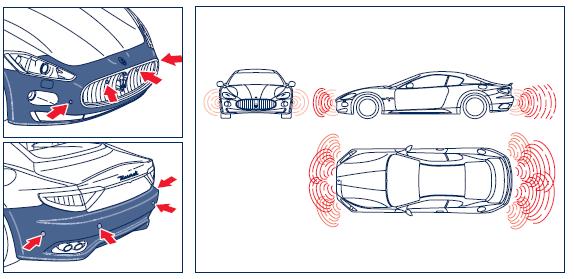
Climatecontrol
The air conditioningsystem usedbythe GranturismoS isthe sameasthatadopted bythe automaticversion.
Refrigerant
The refrigerantusedis R134a. PAG RL -897
Thisvehicle's system isfullychargedwith: 600 ±30 g ofrefrigerant

Lubricant
The lubricantusedis UconRL897 oil
Thisvehicle's system isfullychargedwith: 200ml ±10 ml oflubricant.
The MMS uses Bluetooth technology, which means that the system can be connected to a Bluetooth-enabled mobile phone. The connection enables the MMS to be used for making or receiving calls (by means of the hands-free function), and for managing the mobile phone address book. The connection can be established in two ways:
1. By pairing a mobile phone with the MMS.
2. By linking a stored mobile phone to the MMS.
The mobile phone only has to be paired with the MMS on the firstconnection. Pairing can only be done from the mobile phone; it cannot be done from the MMS interface, since the system is not configured to search for Bluetooth devices. Linking a stored mobile phone connects the MMS to a phone which has already been paired with the system. A link must be established each time that the user wishes to operate the Bluetooth mobile phone via the MMS. Unlike pairing, this operation can be performed either from the mobile phone or from the MMS.
Pairing a mobile phone
WARNING: Before proceeding with the connection, consult the userguide of the mobile phone to be paired with the MMS system.
To pair a phone with the system, the Bluetooth function must be activated on both devices. To prepare the MMS for pairing with a mobile phone, proceed as follows: -switch on the mobile phone; -turn the ignition key to ON without starting the engine; -switch on the MMS by pressing the rotary knob 20; to activate the Bluetooth pairing function on the mobile phone, refer to the instructions in the user guide supplied with the phone. During the pairing operation, the phone requests a PIN code from the user, see page 5 “Authentication code”. If the code is entered correctly, the connection between the two devices is established. Depending on which address book synchronisation mode is set, see page 5 “Address book synchronisation mode”, address book contacts stored in the mobile phone can be browsed directly from the MMS. Once the connection is established, a message appears on the MMS display informing the user that the pairing operation is complete.
The MMS can be paired with up to 10 devices. If 10 paired devices are already stored in the system, to store a new one simply select a listed device,which will be deleted in favour of the new device.
Buttons and functions
1) EjectCD.
2) Selectmode: Radio, CDor Jukebox.
3) Brieflypress
Radio mode: selectfrequency band FM1 –FM2 –FMAST –AM. Press and hold
Radio mode: autostore stationsin FMAST.
4) Telephonemode ON. Makecall. Acceptincomingcall.
5) Navigationmessagerepeat ON.
6) Insert/loadCD.
7) Exita playlist or go back toa previouslevel ofthe menu.
8) Radio mode: move up the wavebandin smallincrements tothe nextstation fromthe currentlytunedstation. CDMP3 and Jukebox modes: selectpreviousalbum.
Menu: navigate the menu options.
9) WithStandard Hi-Fi system: Radio CDand Jukebox modes: Audio settings(musictype, bass, treble, F-B balance, L-R balance, loudness, automaticvolume adjustment).
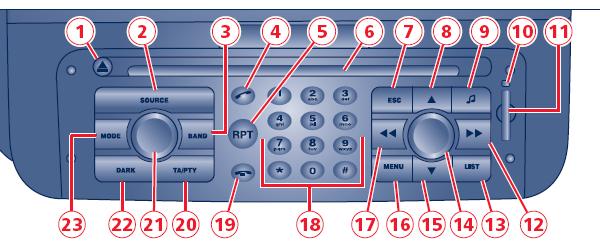
WithBoseHi-Fi system (on request): Radio CDand Jukebox modes: Audio settings(bass, treble, F-B balance, L-R balance, centrepoint).
10) SIM card adaptereject button.
11) SIM card adapter
12) Brieflypress
Radio mode: automatically searchforthe nextradio station. CDand Jukebox modes: moveto nexttrack.
Menu: navigate the menu options. Press and hold
CDaudio mode: fast forward througha track
13) Brieflypress
Radio mode: display listofreceivablestationsin alphabeticalorder.
CDaudio mode: display tracklist.
CDMP3 and Jukebox modes: display album and track list.
Press and hold
Radio mode: update listofstations
14) Telephone, Navigation, Audio (Radio, CDaudio and MP3, Jukebox) and Trip modes: open the menu forthe selectedfunction. Menu: rotate to selectthe function, elementor value, then press the knobto confirm.
15) Radio mode: move down the wavebandin small Incrementstothe previousstation fromthe currentlytuned station.
CDMP3 and Jukebox modes: selectnextalbum. Menu: navigate the menu options.
16) Brieflypress Access the mainmenu Press and hold Access the help menus.
17) Lightlypress
Radio mode: automatically searchforthe previousradio station.
CDand Jukebox modes: movestothe previoustrack ifpressedwithin3 secondsofthe start ofthe track, otherwise replaysthe current track.
Menu: navigate the menu options. Press and hold
CDaudio mode: fast reverse througha track.
18) Brieflypress
Radio mode: selectpreset stations(1–6)
Telephonemode: dial telephonenumber (1 –12) or typetext. Quickselectionofa name beginningwiththe chosenletter, from the addressbook storedon the SIM card. Press and hold Storecurrentstation (1 –6).
19) Telephonemode: Reject incomingcall. End the callin progress.
20) Brieflypress
TA (TrafficAnnouncements): activatethisfeatureto receiveautomatictraffic announcements.
Functionsonlyavailablein countries withanRDS broadcast service.
Press and hold
PTY (ProgrammeType): activate searchfiltertolocate a station broadcastingthe selected programmecategory.
21) Withthe ignitionkey set to ON or the enginestarted: Audio OFF/ON
Withthe ignitionkey set toSTOP: System ON/OFF twice: dark display. threetimes: restoredefault brightnessdisplay.
Rotate: adjustvolume.
22) Brieflypress once: dimdisplay.
Press and hold
Reinitialisesystem
23) Changecurrentdisplay in the right-hand sectionofthe screen (Radio, Map, Trip computer, Telephone).
24) Increaseaudio volume.
25) Decreaseaudio volume.
26) Brieflypress
Radio mode: tuneup the waveband tothe nextdetected station;
CDand Jukebox modes: select nexttrack.
Press and hold CDaudio mode: fast forward througha track.
27) Brieflypress
Radio mode: tunedown the waveband tothe nextdetected station;
CDand Jukebox modes: moves tothe previoustrack ifpressedwithin3 secondsofthe start ofthe track, otherwise replaysthe current track.
Press and hold CDaudio mode: fast reverse througha track.
28) Selectmode: Radio, CDor Jukebox.
29) Mute function ON/OFF.
30) Radio mode: move up the wavebandin smallincrements tothe nextstation fromthe currentlytuned station.
CDMP3 and Jukebox modes: selectnextfolder. Menu: navigate the menu options.
31) Radio mode: move down the wavebandin smallincrements tothe previousstation fromthe currentlytuned station.
CDMP3 and Jukebox modes: selectpreviousfolder. Menu: navigate the menu options.
32) Confirmthe function, elementor valueselected.
33) Vocalcommandfunction ON/OFF.
NavigationSystem mode: enablesvocal instructionsduringthe journey, also showsinformation aboutthe route.
34) Brieflypress Telephonemode ON. Makeoutgoingcall. Acceptincomingcall. End the callin progress. Press and hold Rejectthe incomingcall.
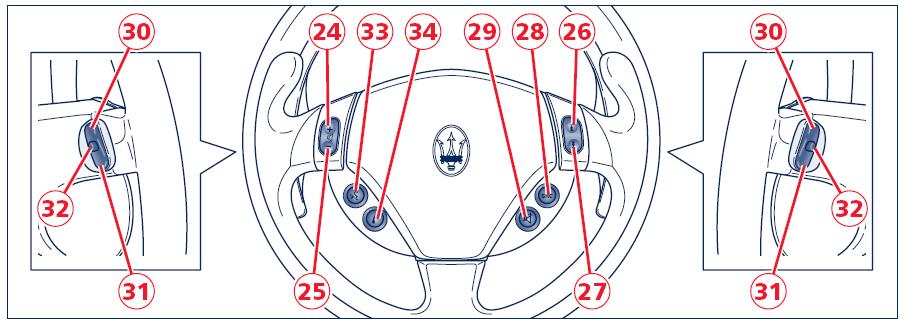
Bluetooth main screen
Press the MODE button, or press the MENU button and select Telematic mode, to access the Bluetooth screen, see Fig. 1. The screen indicates the following parameters:
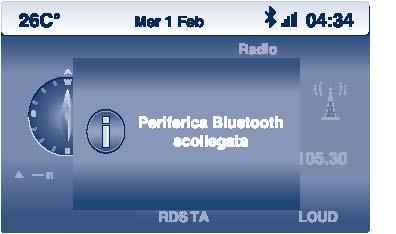
A) connection status
B) network operator
C) name of the paired device
D) battery charge level
E) roaming indicator (if enabled) Disconnection
The Bluetooth connection may be interrupted in one of three ways:
1.By interrupting the connection from the mobile phone, following the steps described in the corresponding user guide, or by switching the mobile phone off;
2. By means of the MMS interface.
4 “List of connected devices”;
3.By moving the Bluetooth-enabled phone away from the MMS so that the signal leaves the MMS reception area. Disconnection is indicated by thepop-up message shown in Fig. 2.

Disconnecting the telephone does not delete the list of calls stored in the call log. To delete the list, proceed as follows:
-press the MENU button
-select icon A and confirm by pressing the rotary knob
-select and confirm, by pressing the rotary knob, the “Telephone Functions" option;
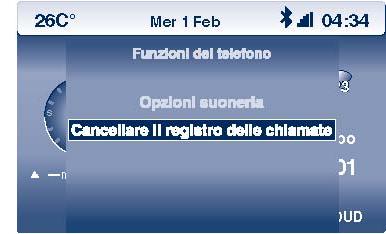
-select and confirm, by pressing the rotary knob, the “Delete call log”, option, see Fig. 3;
The log will not be deleted until the operation has been confirmed a second time.
Switching on the MMS
Each time that the MMS is switched on and provided that Bluetooth mode is active, the system searches for previously paired devices (stored in the memory). The search begins with the last paired device and moves on to previous devices in chronological order.
The search ends when the MMS detects a paired phone and establishes the connection, or when it detects an unpaired phone. In the latter case, to establish a connection, first pair the telephone by selecting ”PAIR TELEPHONE”. If the system fails to find a device, the search ends and the Bluetooth function is disabled.
Making and receiving calls
Calls can be managed either from the mobile telephone or from the MMS. The MMS display indicates the status of the active call, whether incoming and outgoing. To make an outgoing call from the MMS, open the Call menu as follows:
-press button (4) or
-in Telematic mode press the RH rotary knob (13)
-in Telematic mode, select and confirm the "Call" function using the RH rotary knob (13). The display shows the following functions:
-Call list
-Dial
- Directory
FunctionslinkedtoBluetooth mode
In the Telematicmode menu you willfind“Bluetooth functions”
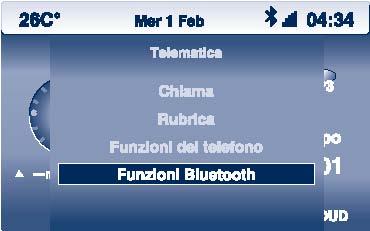
Bluetooth functions
Select“Bluetooth functions”byrotatingthe knob(13), thenpress toconfirmand access the followingfunctions(seeFig. below)
-Bluetooth activationmodes
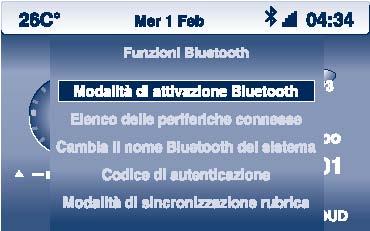
-Listofconnecteddevices
-Changethe system Bluetooth name
-Authenticationcode
-Addressbook synchronisationmode
Bluetooth activation modes
Use this menu to select the Bluetooth operation mode from the following options:
-Off
-On and visible
-On and hidden
Off
When this function is selected, Bluetooth is disabled and therefore the system cannot detect any devices.
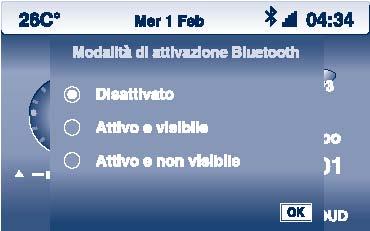
On and visible.
The MMS is configured to connect with previously stored devices or to pair with new devices. Note that the MMS only permits new pairings when no link is established with a previously stored device. The MMS can only be linked with one mobile phone at a time; further linkup requests will be ignored.
On and hidden
The MMS is configured to connect with previously stored devices,but not to pair with new devices.
List of connected devices
This menu displays the list of paired devices. The devices are listed in chronological order, starting with the most recently connected device. If a listed device is paired with the system, the corresponding item will be highlighted. If an active link is established with a listed device, this will be indicated by means of an iconon the display. At the bottom of the screen (see Fig. 7), the following four buttons are displayed:
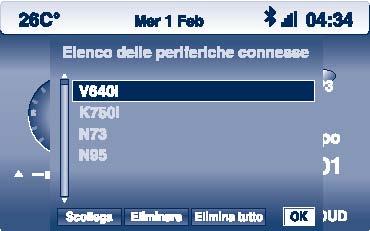
-Connect/disconnect.
-Delete.
-Delete all.
-OK.
Connect/disconnect
Use the rotary knob (13) to select the item corresponding to thetelephone that you wish to connect/disconnect. This function is used to connect or disconnect the telephone from the MMS. Delete
Select this option to delete the selected telephone from the list of stored devices.
Delete all
Select this option to delete the entire list of stored devices. Ok
Select this option to close the window without making any changes.
Change the system Bluetooth name
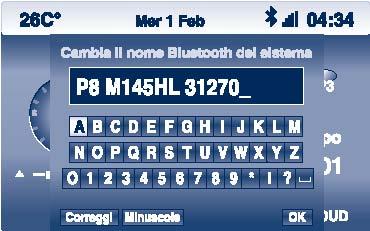
Select this function by rotating and pressing the rotary knob (13), to change the name that the MMS assigns to the mobile phone during and after pairing. The buttons at the bottom of the screen control the operations relating to this function. The screen corresponding to this function is shown in Fig. 8. To exit the function and save the new name, confirm the selection by pressing “OK"
Authentication code
Select this function by rotating and pressing the rotary knob (13), to change the PIN code which must be inputted on the mobile phone during connection to the MMS. If you need to correct the code during input, select the "Correct" button located at the bottom of the screen. To exit this function and save the new code, confirm the selection by pressing “OK”.

Address book synchronisation mode
Use this function to download address book contacts so that theycan also be browsed from the MMS.
The options available on the corresponding screen are:
-No synchronisation
-View address book
-View address book on SIM card
-View all address books
Depending on which function is enabled, contacts stored in the mobile phone address book will be downloaded onto the MMS during the pairing operation. Downloaded contacts may then also be consulted from the MMS. Successful/failed download operations are indicated by the relevant pop-up message on the display.
Address Book Menu
In the Address Book menu you will find an “Exchange using Bluetooth”function, see Fig. 10, which enables contacts in the mobile phone address bookto be downloaded to the MMS address book. Use the rotary knob (13) to select and confirm this function. The display then lists the following options:

-Get all elements
-Get one element
Get all elements
Select this option to copy all the addresses and numbers in the mobile phone address book. During the operation, a message indicates that copying is in progress. To interrupt the operation, press ESC.
Get one element
Select this option to copy a specific entry from the mobile phone address book to the MMS address book. When this function is opened, the display lists all entries stored in the mobile phone address book. Use the right-hand knob (13) to select and confirm the entry that you wish to copy. During the operation, a message indicates that copying is in progress.
Summaryofconnection status symbols
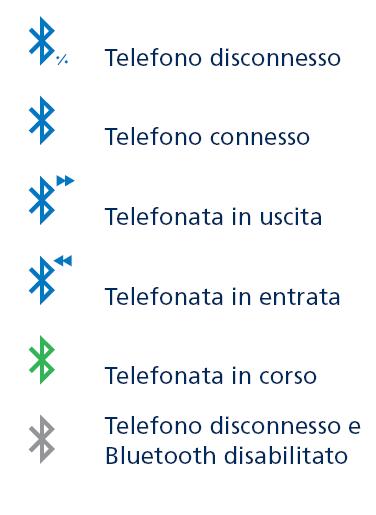
USB port full
The USB port is located inside the glove box. It allows for the exchange of data and the recharging of connected sources. If the connected memory stick contains MP3 files, these files are played automatically. This does not occur if another music source is currently selected. In this case, select the USB function by repeatedly pressing the Source button (2). In any case, playback always begins after the memory stick has been read by the system. The time taken for the read operation depends on the type of content stored in the USB device.
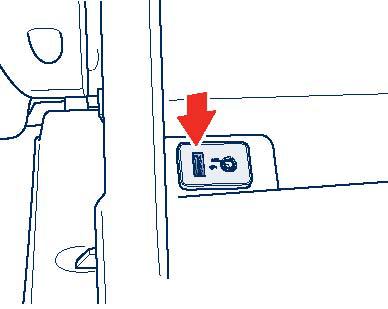
The USB screen shows the following information:
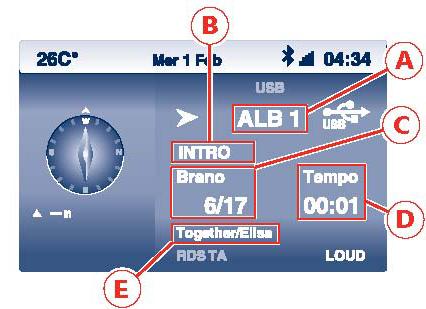
A -name of the folder containing the file being played;
B -status of the Introscan/Random/Repeat functions;
C -number of the file being played and total number of files;
D -elapsed playing time of the current track;
E -track title and album title (if available).
Select album
With USB mode active, press button (14) to select the next album. Press the button again to move forward by one album. Alternatively, press button (7) to select the previous album
Select track
To select a track, proceed as follows:
Next track:
-briefly press button (11).
Previous track:
-briefly press button (16).
To replay the current track; press again to select the previous track.
USB mode menu
Repeatedly press the MODE button (22) until USB mode is displayed. Press the rotary knob (13) to display the following menu:
-Copy USB to Jukebox
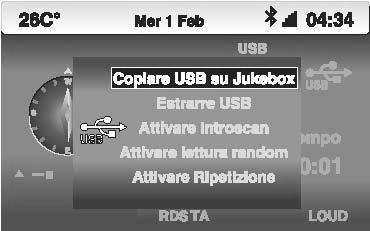
-Remove USB
-Introscan ON
-Random ON
-Repeat ON
Copy USB to Jukebox
Confirm this function by pressing the rotary knob (13), to display a submenu containing the following options:
-All content
-Select multiple
-Current album
-Current track
During the copy operation, the REC icon appears on the display and the only functioning source in Audio mode is the Radio. This menu may be opened from the main menu (press the MENU button 15), by selecting the “Audio functions”mode and then “USB”from among the listed options.
Remove USB
This function enables the USB stick to be removed from the port. It generates a pop-up message authorising the user to proceed. Do not remove the USB stick without first enabling this disconnect function. Failure to do so may result in data loss.
Introscan ON
Select and confirm this function to listen to a preview of all the tracks contained in the USB stick, in their listed order. To disable this function, press the rotary knob (13) then select “Introscan OFF”and confirm.
Random ON
Select and confirm this function to listen to tracks from the USB stick in random order; when this mode is active, the letters RDM are shown on the display. To turn this function off, press the rotary knob (13) then select “Random OFF”and confirm.
Repeat ON
Select this function using the rotary knob (13) to play a folder / album repeatedly. To disable this function, press the rotary knob (13), then select “Repeat OFF”and confirm.
LIST function
Displays a list of albums stored in the memory stick which is currently plugged into the USB port. To activate this function, press the LIST button (12) during playback in USB mode. To access a particular track list, select the desired album using the rotary knob (13) and press to confirm. To play a track from the list, select the desired track using the rotary knob (13) and press to confirm.





